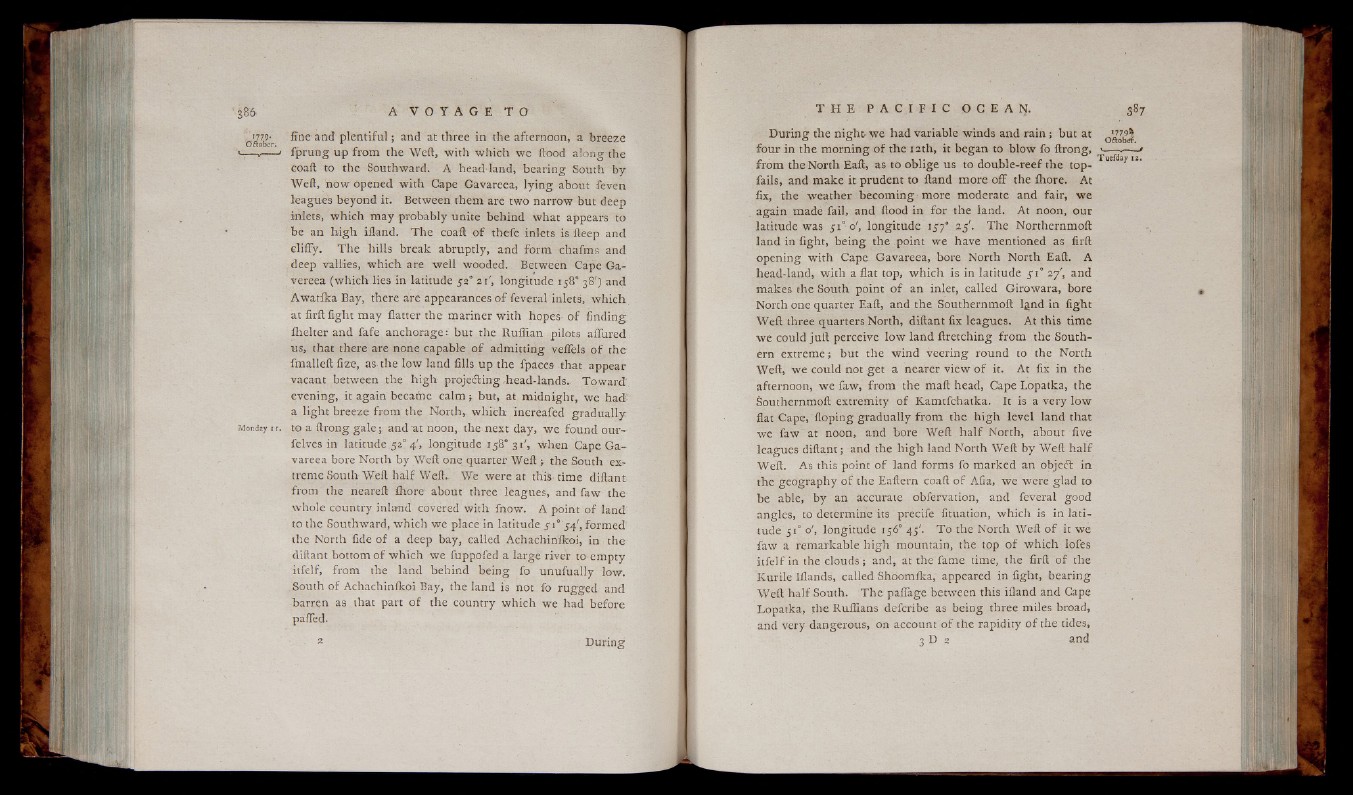
„ '779- line and1 p len tifu l; and at three in the afternoon, a breeze
Octob er;
u— i---- • fprung up from the Weft, with which we flood along the
coaft to the Southward. A head land, bearing South by.
Weft, now opened with Cape Gavareea, ly in g about feven
leagu es beyond it. Between them are two narrow but deep
inlets, which may probably unite behind what appears to
be an h igh ifland. The coaft o f thefe inlets is fteep and
cliffy. T he hills break abruptly, and form chafms and
deep vallies, which are well wooded. Between Cape Ga-
vereea (which lies in latitude $a° zi', longitude 158” 3 81) and
Awatfka Bay, there are appearances o f feveral inlets, which
at firft fight may flatter the mariner with hopes- o f finding
ihelter and fafe anchorage: but the Ruffian pilots allured
us, that there are none capable o f admitting veflels o f the
fmalleft fize, as the low land fills up the fpaces that appear
vacant between the high projedting ,head-lands. Toward“
evening, it again became calm ; but, at midnight, we had?
a light breeze from the North, which increafed gradually
M o n d a y i t . to a ftrong g a le ; and at noon, the next day, w e found our-
felves in latitude 52° 4', longitude 158’ 31', when Cape Gavareea
bore North by Weft one quarter Weft ; the South ex*-
treme South Weft half Weft. We were at this time diftant
from the neareft ihore about three leagues, and faw the
whole country inland covered with fnow. A point o f land
to the Southward, which we place in latitude 51° 54', formed
the North fide o f a deep bay, called Achachinlkoi, in the
diftant bottom o f which we fuppofed a large river to empty
itfelf, from the land behind being fo unufually low.
South o f Achachinlkoi Bay, the land is not fo rugged and
barren as that part o f the country which we had before
paffed.
During the night- w e had variable winds and rain j but at
four in the morning o f the 12 th, it began to blow fo ftrong, >--- <•— •
from the North Eaft, as to oblige us to double-reef the top- Tue day I2,
fails, and make it prudent to ftand more o ff the ihore. At
fix, the weather becoming more moderate and fair, we
again made fail, and flood in for the land. At noon, our
latitude was 51° o', longitude 157’ 25'. The Northernmoft
land in fight, being the point we have mentioned as firft
opening with Cape Gavareea, bore North North Eaft. A
head-land, with a flat top, w hich is in latitude j'i° 27', and
makes the South point o f an inlet, called Girowara, bore
North one quarter Eaft, and the Southernmoft Ignd in fight
Weft three quarters North, diftant fix leagues. At this time
we could juft perceive low land ftretching from the Southern
extreme; but the wind veering round to the North
Weft, we could not ge t a nearer view o f it. At fix in the
afternoon, we faw, from the mail: head, Cape Lopatka, the
Southernmoft extremity o f Kamtfchatka. It is a very low
flat Cape, Hoping gradually from the high level land that
we faw at noon, and bore Weft h a lf North, about five
leagues diftant; and the high land North Weft by Weft h a lf
Weft. As this point o f land forms fo marked an objeft in
the geography o f the Eaftern coaft o f Afia, we were glad to
be able, by an accurate obfervation, and feveral good
angles, to determine its precife flotation, which is in la titude
51° o', longitude 156° 45'. To the North Weft o f it we
faw a remarkable high mountain, the top o f which lofes
itfe lf in the c lo u d s ; and, at the fame timé, the firft o f the
Kurile Iflands, called Shoomika, appeared in fight, bearing
Weft half South. T he paffage between this ifland and Cape
Lopatka, the Ruffians defcribe as being three miles broad,
and very dangerous, on account o f the rapidity o f the tides,
3 D 3 and